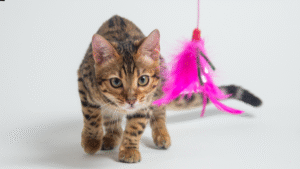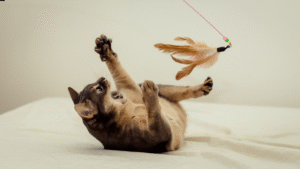Many cat owners believe that cats are too independent or stubborn to be trained. After all, unlike dogs, cats don’t necessarily want to please their owners, so teaching them tricks might seem like a difficult task. In reality, cats are observant, clever, and highly trainable. With the right approach, you can teach your cat a variety of tricks such as “sit,” “high five,” “fetch,” and “spin.”

Cat Training 101: Understanding Cat Psychology and Motivation
Before diving into the details of cat training, it’s important to understand how cats think. Unlike dogs, cats are not pack animals and are not naturally motivated to please humans. Instead, cats are driven by reward-based behavior — if an action benefits them in some way, they’re likely to repeat it.
While every cat is unique, most are motivated by food, play, or affection. You’ll need to determine what your cat responds to best in order to make training effective.
Here are a few common motivators:
-
Food: Many cats are highly food-motivated. Small treats or pieces of cooked chicken often work well.
-
Play: Some cats are more motivated by playtime with their favorite toy or a session with a feather wand.
-
Praise: Certain cats respond positively to petting or verbal praise.
Experiment to find what motivates your cat the most. Once you discover their preferred reward, use it consistently to reinforce good behavior during training.
Tips for Setting Up a Cat Training Space
Cats are easily distracted, so you’ll want to find a quiet location with minimal interruptions for training sessions. Make sure the environment feels safe and comfortable — a stressed or anxious cat will not learn effectively.
Here are a few tips for setting up the perfect training environment:
-
Keep sessions short: Cats have short attention spans. Limit training to 5–10 minutes at a time.
-
Pick the right time: Choose a time when your cat is alert and mildly hungry — not full, starving, or sleepy.
-
Be patient: Cats learn at their own pace. Don’t rush or show frustration.
-
Use consistent cues: Use the same words or gestures for each command to avoid confusion.
Positive Reinforcement: Reward-Based Training
Positive reinforcement is the cornerstone of successful cat training. You should reward your cat immediately after they perform the desired behavior, rather than punishing them for not understanding. Punishment creates fear and mistrust but does not promote learning.
Whenever your cat performs or even approximates the desired behavior, reward them right away. Over time, your cat will associate that behavior with positive outcomes and repeat it. One of the most effective ways to do this is through clicker training.

Clicker Training for Cats
Clicker training is one of the most popular and effective cat training methods. It uses a small handheld device that makes a distinct “click” sound when pressed.
Here’s how to introduce clicker training to your cat:
-
Introduce the clicker: Click the device and immediately give your cat a treat. Repeat this 10–15 times so your cat learns that the sound means a reward is coming.
-
Start with simple commands: Once your cat associates the click with a treat, begin using the clicker during training.
-
Click at the right moment: Timing is crucial. Click the instant your cat performs the desired behavior to clearly mark what they did right.
Clicker training helps your cat understand your commands more easily and strengthens communication between you and your pet.
Cat Training: Teaching Simple Tricks Step-by-Step
Once your cat understands how training works, you can start teaching them some fun and simple tricks.
1. Teaching Your Cat to “Sit”
“Sitting” is one of the easiest tricks to start with and serves as a great foundation for other commands.
Steps:
-
Hold a treat just above your cat’s head so they have to look up.
-
Slowly move the treat back toward their ears. As they follow it, their rear will naturally lower to the ground.
-
When your cat sits, click (if using a clicker) and give them the treat.
-
Repeat several times, then begin saying “Sit” just before you lure them into position.
After a few sessions, your cat will associate the word “Sit” with the action and perform it on command.
Related:How To Train Your Cat To Walk On A Leash
2. Teaching “High Five”
This fun and impressive trick is surprisingly easy to teach.
Steps:
-
Hold a treat in your hand where your cat can see it.
-
Close your hand and wait. Many cats will instinctively paw at your hand to get the treat.
-
When your cat touches your hand with their paw, click and reward them.
-
Gradually start raising your hand higher and say “High five!” before they touch it.
-
Reward your cat every time they make contact.
With repetition, your cat will lift their paw when you say “High five!”
3. Teaching “Spin”
“Spin” is a fun trick that improves your cat’s focus and agility.
Steps:
-
Hold a treat near your cat’s nose.
-
Move it slowly in a circular motion so your cat follows with their head and body.
-
Once they make a full circle, click and reward them.
-
Add the verbal cue “Spin” just before guiding them.
After several sessions, your cat will spin on command without needing a lure.

4. Teaching “Fetch”
Although often associated with dogs, many cats can learn to fetch with the right motivation.
Steps:
-
Choose a lightweight toy your cat likes, such as a small ball or crinkle toy.
-
Toss it a short distance away.
-
When your cat picks it up, call them back using an encouraging tone.
-
When they drop the toy near you, click and reward them.
-
Gradually increase the distance and reward your cat each time they return the toy.
Fetch can take time to master, but it provides excellent mental and physical stimulation.

Common Training Issues and How to Fix Them
Even with patience and consistency, you may encounter some challenges during training. Here are a few common issues and their solutions:
-
Issue: Your cat gets bored or loses interest quickly.
Solution: End training before your cat becomes bored. Always stop on a positive note. -
Issue: Your cat ignores your commands.
Solution: Reevaluate your reward. The treat may not be enticing enough. Try a higher-value reward, such as tuna or chicken. -
Issue: Your cat walks away during training.
Solution: Don’t chase or force them to participate. Let them leave and try again later when they’re more receptive. -
Issue: Your cat’s behavior is inconsistent.
Solution: Stay consistent with commands, tone, and rewards. Cats thrive on clear, predictable communication.
Remember — your cat isn’t being stubborn. They simply learn differently and often more slowly than dogs.
Advanced Cat Tricks to Try
Once your cat has mastered the basics, you can move on to more advanced tricks.
-
Jumping through hoops: Start with a low hoop and gradually raise it as your cat gains confidence.
-
Target training: Teach your cat to touch their nose to a target stick, which can be the foundation for many other tricks.
-
Walking on a leash: With patience, many cats can learn to walk comfortably on a harness and leash.
Always progress slowly and reward generously for each success.

Why Training Your Cat Is a Great Idea
Training your cat offers numerous benefits beyond just entertainment.
-
Mental stimulation: Trick training keeps your cat’s mind active and helps prevent boredom.
-
Physical exercise: Many tricks involve movement, helping your cat stay fit and healthy.
-
Stronger bond: Training builds trust and deepens your connection with your cat.
-
Reduced problem behaviors: A mentally and physically engaged cat is less likely to scratch furniture or meow excessively.
Training enhances both your cat’s well-being and your relationship with them.
Conclusion
Training your cat to do tricks takes patience, consistency, and an understanding of feline behavior. Cats are independent by nature and not motivated by praise alone, but with the right techniques, you can teach them a wide range of fun and engaging tricks.
Start with simple commands like “sit,” “high five,” and “spin.” Keep sessions short, use rewards your cat loves, and apply clicker training to make communication clear. As your cat masters the basics, move on to more complex and advanced tricks.
- 5 Cheap Alternatives To Dog Training Equipment - November 12, 2025
- Homemade Calming Spray To Help Dogs During Training - November 12, 2025
- 7 DIY Dog Training Tools You Can Make From Household Items - November 12, 2025
